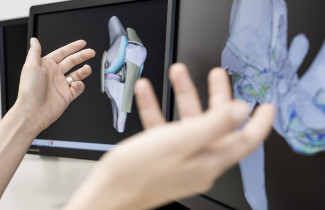Osteoarthritis (OA) is a degenerative disease that affects tens of millions of people worldwide. Obesity and joint injuries are well-known factors increasing the risk of OA. The early detection of cartilage injuries would be vital in order to prevent further tissue degeneration that typically leads to post-traumatic osteoarthritis (PTOA). For instance, ~50% of patients with anterior cruciate ligament or meniscal tear develop PTOA in 10-20 years after the injury. However, the currently available diagnostic techniques have only a limited ability to detect the early degeneration. Computed tomography (CT) is a readily available imaging device with excellent image resolution. However, evaluating the condition of soft tissues (e.g., cartilage) requires the use of contrast agents. Contrast-enhanced computed tomography (CECT) allows the detection of cartilage loss at lesion sites, segmentation of articulating tissues and provides information on cartilage health based on the diffusion of the contrast agents into the tissues. In addition, a major advantage of using the contrast agents is the simultaneous imaging of cartilage and bone, which is crucial for the diagnosis of an arthritic condition.
The early signs of cartilage degeneration include disruption of superficial collagen, loss of proteoglycans (PGs), and increase in water content. These degeneration related changes alter the diffusion of the contrast agents into cartilage. The diffusion of anionic and cationic contrast agents into cartilage is inversely and directly proportional to the fixed charge density that the PGs create inside cartilage, respectively. However, non-ionic agents have no affinity to PGs and diffuse freely based on the tissue water content and permeability. Cationic contrast agent (CA4+), at diffusion equilibrium, is significantly more sensitive to detect proteoglycan loss in cartilage compared to conventional anionic agents. However, during degeneration, the loss of PGs and the increase in tissue water content occur simultaneously, having opposite effects on the cationic agents' diffusion. This leads to reduced sensitivity to detect alterations using the agent before the diffusion equilibrium, i.e., during the first hours after an intra-articular administration. Thus, the diagnostic sensitivity of CA4+ could be improved by being able to exclude the effect of the altered water content attributing to the diffusion.
The thesis focuses on the development of a quantitative dual-energy computed tomography technique (QDECT) to improve the diagnostic sensitivity of the cationic agent to detect changes in cartilage health. The technique utilizes a combination of the CA4+ agent simultaneously with a non-ionic gadolinium-based agent (gadoteridol). With the use of two separate X-ray energies, the iodine and gadolinium-based contrast agents can be simultaneously quantified. The results show the QDECT to enhance the sensitivity of the cationic agent to characterize cartilage structural and functional status. Further, the technique is applicable already at clinically relevant time points, i.e., imaging can be done within 1 hour after the contrast agent administration. This work also clarifies the effect of articular cartilage constituents (PGs, collagen, and water) to the diffusion of cationic and non-ionic contrast agents in a depth- and time-dependent manner. The acquired results are valuable when future contrast media are designed and help in optimizing the timing of scanning. The QDECT technique introduced in the thesis and the findings lay the foundation for further development of the quantitative technique towards potential future application in clinic.
The doctoral dissertation of MSc Abhisek Bhattarai, entitled Novel dual-contrast computed tomography technique for detection of cartilage injuries will be examined at the Faculty of Science and Forestry on the 16th of October online. The opponent in the public examination will be Assistant Professor Sarah Manske, University of Calgary, Canada and the custos will be Postdoctoral Researcher Janne Mäkelä, University of Eastern Finland. The public examination will be held in English.


